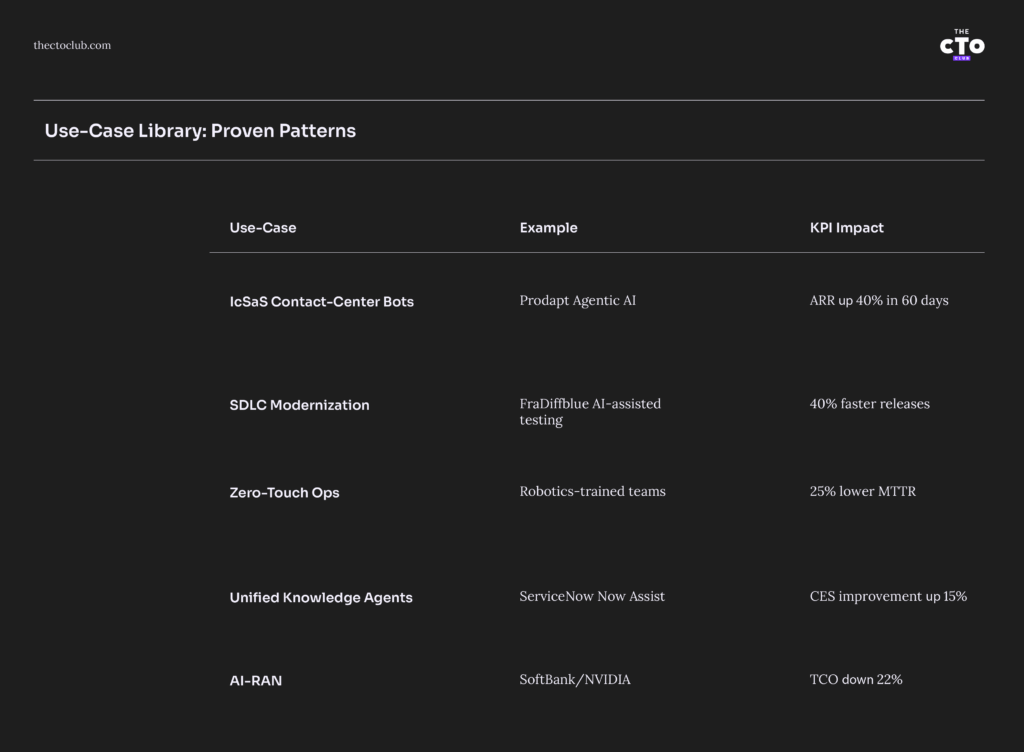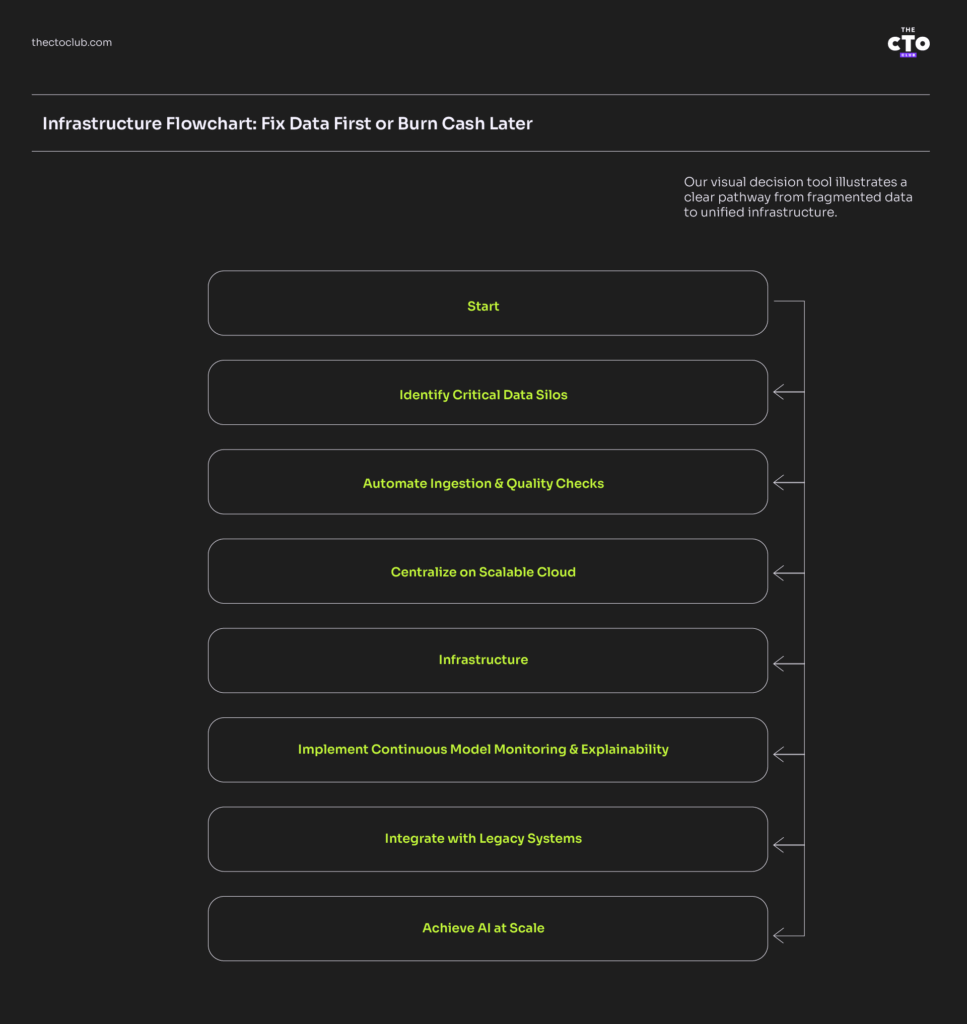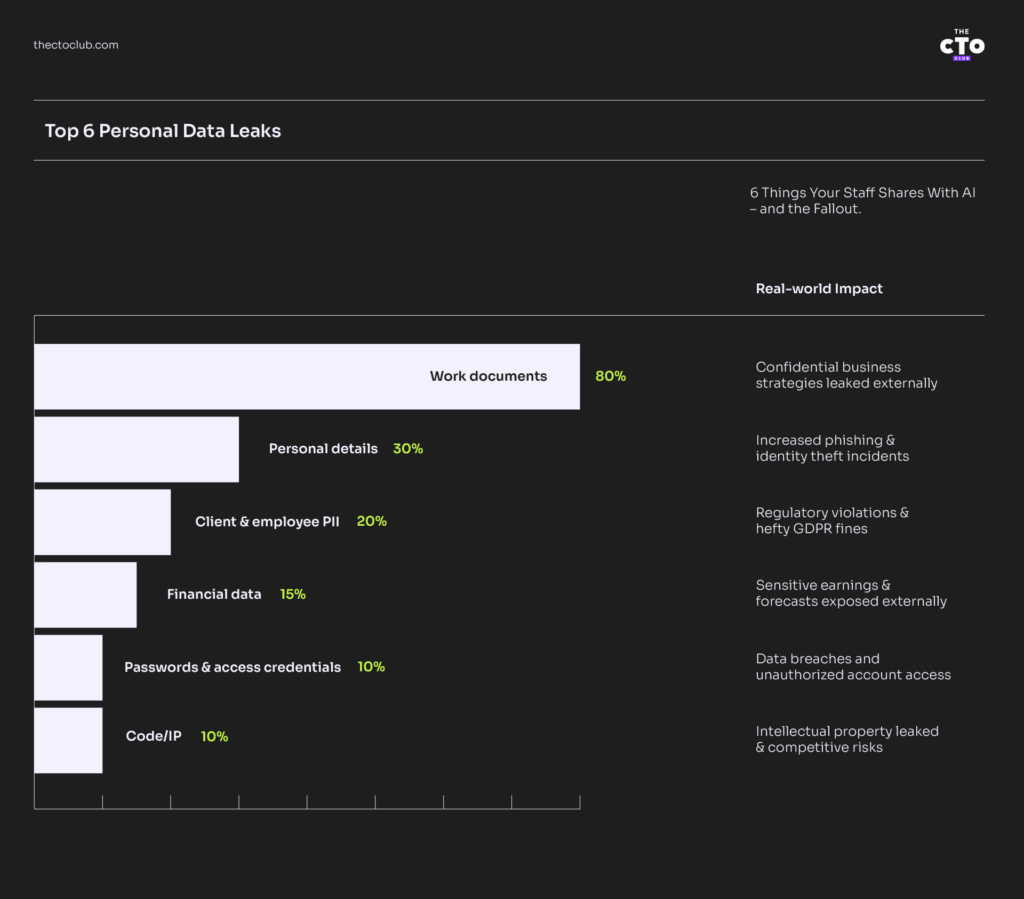The AI ROI Playbook gives CTO-level leaders the tools to turn pilots into profit. Here, you’ll find proven frameworks, board-ready metrics, and real-world examples so you can move fast and scale what works.
Everything here is hands-on so that you can take immediate action!
How to Use This Playbook:
- Skim the Executive Snapshot to see what your peers are saying.
- Run the Maturity Self-Assessment to benchmark your organization's AI readiness.
- Jump directly to chapters that address your current needs (Use Cases, People, Infrastructure, Data-Pipeline Readiness, Quick Start Plan).
- Use the downloadable worksheets provided to take immediate action.
Executive Snapshot
In 2025, we know AI works; now you must decide how to make it work for your business.
These executives spotlight what it takes to move from experimentation to execution: aligned data, objective metrics, practical governance, and AI that augments people, not replaces them.
- Rajiv Papneja, CTO, Prodapt: “2025 will be about taking the AI impact from Proof to Value. Expect new customer success KPIs such as Agentic AI Resolution Rate (ARR), First Contact Resolution (FCR) for AI, AI-driven CSAT, and AI-assisted AHT and CES.”
- Erik Reeves, CTO, Anaqua: "32% of IT leaders report no ROI from AI projects due to starting with technology rather than clearly defined business problems."
- Steve Lucas, CEO, Boomi: "Disconnected data remains the #1 barrier to AI success, with enterprises juggling 360+ SaaS apps and thousands of data sources."
- Narayana Shankar Prasad, CTO, Zensar: “While every organisation has played around with this new toy, only a few have deployed GenAI into production to understand the benefits and comprehend how unequipped their data landscape is to handle GenAI. Organisations will realise that ‘getting data ready for GenAI’ is the key to delivering business value. Tech companies will incorporate GenAI into data platforms as a means of ‘design by default’, thereby disrupting the data and analytics market. Pioneers will start defining GenAI strategy underpinned by Data Strategy. Organisations will integrate AI and Data capabilities together. Currently, most organisations have set up AI working groups independently, still in the exploratory stage.
- Chandra Venkataramani, CIO, TaskUs: "AI isn't taking jobs—it's creating new ones. Forward-thinking CTOs are using AI to upskill teams and free them from low-value tasks. In customer service, where interactions are growing more complex, GenAI is cutting resolution times from 125 minutes to seconds. The real opportunity? Let AI handle the routine so humans can focus on meaningful, loyalty-building interactions."
- Claus Jepsen, CTO & CPO, Unit4: “Don’t force tech to fit your business—if it doesn’t serve your objectives, walk away. The real innovation edge comes from a culture that constantly questions inefficiencies and includes every user group in the conversation.”
Maturity Self-Assessment
This context clearly guides organizations on where they stand today—and crucially, where to focus efforts next. Download our maturity self-assessment to see where your organization fits in.
Cheaper LLMs with smaller GPU requirements will flood the market, making AI more consumable and practical. Enterprises that proactively measure AI maturity will gain a clear competitive advantage.
— Rajiv Papneja, CTO of Prodapt
Use-Case Library
Explore these AI Use Cases to discover how high-impact teams are leveraging GenAI to address real business challenges, reduce costs, expedite delivery, and drive new revenue.

GenAI-powered bots are already transforming contact center operations by intelligently solving customer problems in under 4–5 clicks.
– Rajiv Papneja, CTO, Prodapt
1. Industry-contextualized Services-as-Software (IcSaS)
- Detailed Context: AI-driven automation specifically trained for industry verticals (telecom, finance, retail, etc.), transforming service delivery from manual, slow, costly processes into streamlined, automated workflows.
- Example: Prodapt deployed Agentic AI bots for Tier-1 Telcos, transforming billing dispute resolution processes that previously required multiple human agents.
- Implementation Steps:
- Identify repetitive customer service tasks.
- Train domain-specific AI models.
- Integrate models into existing customer interaction systems.
- Relevant KPIs: ARR (Agentic AI Resolution Rate) increased by 40% within 60 days, significant drop in AHT (Average Handle Time).
2. SDLC Modernization (AI-assisted Development & Testing)
- Detailed Context: Leveraging AI to accelerate the software development lifecycle, from requirements gathering, coding, unit testing, to deployment, significantly cutting down release cycles and improving code quality.
- Real-World Example: Diffblue provides AI-generated unit tests and test-review processes, significantly speeding code validation for enterprises.
- Implementation Steps:
- Integrate AI test generation tools into CI/CD workflows.
- Run a pilot with a small DevOps team to measure baseline results.
- Scale successful practices across other teams and products.
- Relevant KPIs: 40% faster software release cycles; higher code coverage (25-35% increase).
3. Zero-Touch Operations (AI & Robotics in Ops)
- Detailed Context: Combining robotics-trained talent with AI automation to dramatically reduce manual intervention in field operations, customer installations, or infrastructure management.
- Real-World Example: A major telecom operator in APAC reduced operational MTTR (Mean Time to Repair) significantly by embedding robotics-trained engineers and AI-driven predictive maintenance tools.
- Implementation Steps:
- Integrate predictive AI systems into operational workflows.
- Deploy robotics-trained talent for proactive troubleshooting and maintenance.
- Monitor, measure, and iterate on AI performance and results.
- Relevant KPIs: 25% reduction in operational downtime; faster response to outages.
4. Unified Knowledge Agents (Agentic AI for Knowledge Management)
- Detailed Context: Leveraging agentic AI to centralize internal knowledge and automate responses to employee queries, improving productivity and reducing knowledge silos.
- Real-World Example: ServiceNow’s Now Assist automates internal knowledge retrieval, enabling employees to quickly access relevant documentation and reduce query resolution time.
- Implementation Steps:
- Consolidate internal documentation into a centralized knowledge hub.
- Train an agentic AI model to understand and retrieve relevant data.
- Roll out in pilot teams, measure CES (Customer Effort Score), then expand.
- Relevant KPIs: CES improved by ~15%, with a decrease in manual knowledge queries.
5. AI-RAN (AI-driven Radio Access Networks)
- Detailed Context: Implementing AI to optimize telecom network infrastructure, manage energy consumption, bandwidth, and reduce operational complexity.
- Real-World Example: SoftBank and NVIDIA collaborate to create AI-integrated 5G networks, significantly reducing the total cost of ownership (TCO).
- Implementation Steps:
- Integrate AI into network infrastructure planning and management systems.
- Deploy automated management and energy optimization models.
- Continuously monitor and optimize performance.
- Relevant KPIs: 22% reduction in total cost of ownership (TCO); improved network reliability.
6. Predictive Pricing (Dynamic Pricing with AI)
- Detailed Context: Using AI to dynamically adjust pricing strategies based on real-time data, maximizing profitability without manual oversight.
- Real-World Example: A retail chain leveraged AI predictive pricing tools to respond dynamically to market shifts.
- Implementation Steps:
- Aggregate real-time market and competitor data.
- Deploy predictive AI pricing models.
- Run controlled pilots, measure impact, expand to wider markets.
- Relevant KPIs: Gross margin improvement (+6%) through optimized pricing.
7. GenAI-Driven UX Copy
- Detailed Context: Leveraging Generative AI to quickly produce and localize user interface copy, improving time-to-market and reducing workload.
- Real-World Example: Mattel accelerated the localization of Barbie Dreamhouse apps, dramatically cutting the product launch cycle.
- Implementation Steps:
- Integrate GenAI language models into UX development processes.
- Pilot the system on non-critical releases to evaluate quality and speed.
- Scale up after confirming consistent and high-quality outcomes.
- Relevant KPIs: 50% reduction in launch cycles.
8. Fraud-Signal Fusion (AI for Fraud Detection)
- Detailed Context: AI-driven systems combine multiple data signals to reduce false positives in fraud detection, improving accuracy without increasing workload.
- Real-World Example: A confidential fintech company leveraged AI fusion models to cut chargeback-related false positives.
- Implementation Steps:
- Aggregate fraud-related data signals from multiple sources.
- Implement AI models that can intelligently combine signals.
- Evaluate performance continuously and tune models accordingly.
Relevant KPIs: 30% reduction in false positives, lower operational fraud-management costs.
People & Skills
Don’t neglect talent when you’re scaling AI in your organization. It’s criminally overlooked. Having the right people and skills in place is just as essential as having the right infrastructure and tools.
Successful AI adoption demands skills that integrate AI with real-world operations. Enterprises should focus on talent who understand both automation and operational realities deeply.
— Rajiv Papneja, CTO of Prodapt
Let’s look at two proven, innovative approaches to rapidly acquire and leverage the talent needed to deliver AI ROI at enterprise scale:
Smoothstack’s Hire-Train-Deploy: Rapid AI Talent at Lower Cost
Traditional hiring processes usually suck at delivering specialized AI talent quickly enough, or cost-effectively enough, to keep pace with what businesses need. Smoothstack shared with me their ‘hire-train-deploy’ model that directly addresses this issue. It offers:
- Rapid Training and Deployment – Smoothstack leverages an intensive, accelerated certification process to deliver job-ready Databricks-certified GenAI engineers in as little as 6 weeks. This significantly reduces ramp-up time compared to traditional hiring methods (typically 3–6 months or longer).
- Cost Efficiency – Enterprises leveraging Smoothstack’s approach report approximately 40% lower total hiring and onboarding costs, freeing valuable resources to reinvest in other critical AI initiatives.
- Real-World Application – Organizations struggling to scale AI experiments beyond isolated pilots can quickly access a pipeline of certified specialists capable of implementing enterprise-grade solutions aligned directly with business outcomes.
Implementing a hire-train-deploy model includes:
- Identifying immediate AI skill gaps through the provided self-assessment worksheet.
- Engaging with Smoothstack (or others) to select ideal candidate cohorts (Databricks GenAI Certified Engineers recommended).
- Deploying trained cohorts into real projects immediately post-certification, closely measuring productivity and cost savings.
You’ll know you’re on the path to success based on the following KPIs:
- Time-to-productivity (weeks/months)
- Overall cost savings vs. traditional hires (%)
- AI project success rate pre- vs. post-implementation
Robotics-Trained Talent
Need another example? Integrating physical, real-world operations with software-driven AI automation is a skill set uniquely cultivated by robotics training.
Robotics-trained graduates offer a distinct advantage over traditional computer science-only grads because they possess:
- Resilience & Adaptability – Robotics education inherently involves dealing with real-world uncertainty, constant troubleshooting, and iterative problem-solving. Robotics-trained talent excels in environments where AI applications require continuous iteration and refinement.
- Hardware-Software Integration Expertise – AI is increasingly embedded into hardware (IoT, autonomous systems, smart infrastructure). Graduates from robotics programs arrive prepared with hands-on experience integrating AI software solutions into physical devices, critical for industries like telecom, manufacturing, logistics, and infrastructure.
- Collaboration & Cross-Functional Team Skills – Robotics projects are rarely solo endeavors. Grads come pre-equipped with proven skills in teamwork, cross-functional collaboration, and project management, seamlessly fitting into DevOps teams, product engineering groups, or agile innovation squads.
Integrating robotics-trained talent into your organization can be achieved using our free Robotics Talent Interview Kit. It will help you:
- Clearly define roles suited for robotics-trained talent.
- Identify ideal candidates that possess key behavioral and technical competencies.
- Set you up to successfully deploy robotics-trained talent into operational teams alongside existing AI engineers
- Measure productivity, operational efficiency, and resilience of robotics-trained talent.
You’ll know you’re on the path to success based on the following KPIs:
- Reduction in operational downtime (MTTR improvements)
- Time to integrate software with physical hardware (% improvement)
- Employee productivity and retention rates (pre- vs post-integration)
Infrastructure & Data Readiness
What’s preventing enterprises from achieving practical A? Inadequate infrastructure and data readiness. These are foundational elements for successfully scaling AI from proof of concept (PoC) to measurable business value. Combining automated data pipelines, scalable computing power, and seamless integration – be ready to tackle it all!
Disconnected data is the top barrier to AI success. Enterprises must proactively unify their infrastructure and data ecosystems to ensure their AI investments actually deliver results.
— Rajiv Papneja, CTO of Prodapt
This section provides a detailed framework for assessing and quickly upgrading your organization's infrastructure and data readiness for effective AI deployments. Our technical readiness worksheet will help you determine your current progress in your journey.
Key Components of AI-Ready Infrastructure
To support practical AI initiatives, your infrastructure should encompass these five critical areas:
1. Automated Data Pipelines
Data pipelines must reliably ingest, clean, and label data automatically. Without automated pipelines, data quality degrades, and AI performance suffers.
- Signs of readiness:
- Automated data ingestion from key sources (CRM, ERP, IoT).
- Continuous data quality and validation processes.
- Real-time data lineage tracing and metadata management.
2. Scalable GPU/CPU Infrastructure
Adequate computing infrastructure is crucial as AI models grow larger and more complex.
- Signs of readiness:
- Cloud-based or hybrid platforms that allow flexible scaling.
- Clear policies for GPU usage, provisioning, and cost management.
- Infrastructure that supports the quick deployment of model updates and training runs.
3. Continuous Model Monitoring
Model performance often degrades over time. Continuous monitoring allows teams to quickly detect and correct model drift or biases.
- Signs of readiness:
- Automatic drift-detection alerts built into CI/CD pipelines.
- Established processes for regular retraining and recalibration.
- Dedicated dashboards tracking real-time AI model performance.
4. Robust Legacy System Integration
Practical AI needs to integrate seamlessly into existing business systems to drive real value.
- Signs of readiness:
- APIs and microservices architecture connecting AI systems to legacy platforms.
- Middleware solutions standardize data exchange and system communication.
- Clearly documented integration workflows and best practices.
5. Built-in Explainability & Ethics
Explainable AI (XAI) is essential for regulatory compliance, stakeholder trust, and responsible AI governance.
- Signs of readiness:
- Tools embedded into workflows for assessing model fairness and transparency.
- Processes ensuring ethical reviews as part of deployment cycles.
- Transparency reports made accessible internally and externally.
Fail more than 2 checks in the Technical Readiness Checklist? It’s time to go deeper with the Data Pipeline Readiness Worksheet—a hands-on tool to audit your flows, highlight bottlenecks, and prioritize fixes by impact.
Data Pipeline Readiness Worksheet
If your GenAI pilot felt like driving a Formula 1 car on gravel, your data pipeline might be the problem.
Even the most intelligent AI can’t make decisions with stale, siloed, or mystery-meat data. That’s why we created this worksheet—a hands-on tool to help you audit your full data flow and pinpoint exactly where to fix it.
This is a practical workbook designed for technical teams to:
- Inventory data sources by domain, type, owner, and accessibility
- Map ETL pipelines, including tooling, refresh rates, and transformations
- Score each stage (ingestion, prep, access, governance) on a 1–5 readiness scale
- Flag high-risk gaps—like inconsistent schemas, missing lineage, or PII exposure
- Prioritize remediation with owner, fix type, and effort-level columns
Whether you’re centralizing lakes, cleaning up shadow tables, or prepping for real-time inference, this worksheet gives your team a shared, fix-first action plan.
Infrastructure Flowchart

Guardrails & Compliance
Once you move beyond AI pilot projects, you also encounter new risks: data leaks, privacy breaches, ethical dilemmas, and unauthorized tool usage. Implementing strong guardrails and proactive compliance policies will help mitigate these risks and bring you sustainable value from AI.
Rajiv Papneja emphasizes the importance of cautious, foresighted adoption:
Enterprises must balance AI’s speed and depth with careful governance. Without intentional guardrails, rapid adoption can quickly lead to privacy erosion, bias entrenchment, and loss of control.
— Rajiv Papneja, CTO of Prodapt
This section provides clear guidance, real-world examples, and immediately actionable tools to protect your organization’s AI deployments.
Top 6 Personal Data Leaks
65% of professionals admit to using AI platforms for work-related tasks. We know AI has come a long way in the past few years, making our lives easier in many ways; however, there are significant concerns regarding the use of AI tools in professional environments.
The application security SaaS company Indusface has uncovered the most common data that professionals are sharing with AI and the implications this can have on individuals and businesses.

Quick-Fix Checklist
Take these immediate actions to protect your data:
✅ Mask Personal Identifiable Information (PII) before interacting with AI.
✅ Red-team Prompts: Regularly test AI prompts for vulnerabilities.
✅ Secure Endpoints: Enforce approved enterprise-grade security solutions.
✅ Policy Enforcement: Clearly communicate allowed vs. prohibited uses.
✅ Continuous Employee Training: Provide regular training updates.
90-Day Quick-Start Plan
From pilot fatigue to production ROI — here’s your first 90 days mapped out.
2025 will be the year of taking AI from proof to value. That shift doesn’t happen by accident—it happens through structured sprints, measurable KPIs, and relentless iteration.
— Rajiv Papneja, CTO of Prodapt
Board-Ready KPI Kit
Give executive and board-level stakeholders a clear, confident view of how AI initiatives are performing in a way that’s framed around value creation instead of the tech jargon they might not understand. Use this deck to earn trust, secure budget, and steer the next phase of AI deployment.
Boards increasingly ask for clear, measurable ROI from AI initiatives. New KPIs—ARR, AI-FCR, AI-CSAT, and AI-AHT—will quickly become boardroom staples.
— Rajiv Papneja, CTO of Prodapt
Templates & Tools Library
Easy-to-use templates provided as actionable assets:
Practical AI means hands-on action. Enterprises need simple tools and clear frameworks to quickly baseline performance, identify risks, and scale results.
— Rajiv Papneja, CTO of Prodapt
Want More?
Practical AI doesn’t wait for perfect—start small, move fast, and let value lead. Want help scaling your next step?
Join The CTO Club newsletter and tell us: Where did your last AI pilot stall (Data • Infrastructure • Goals • Cost)? Your answer helps shape the tools and insights we publish next!




